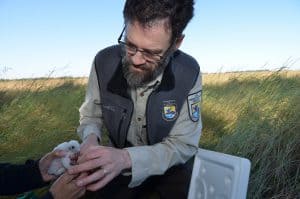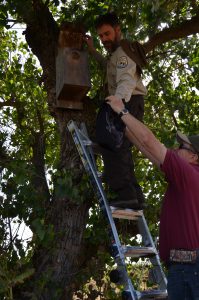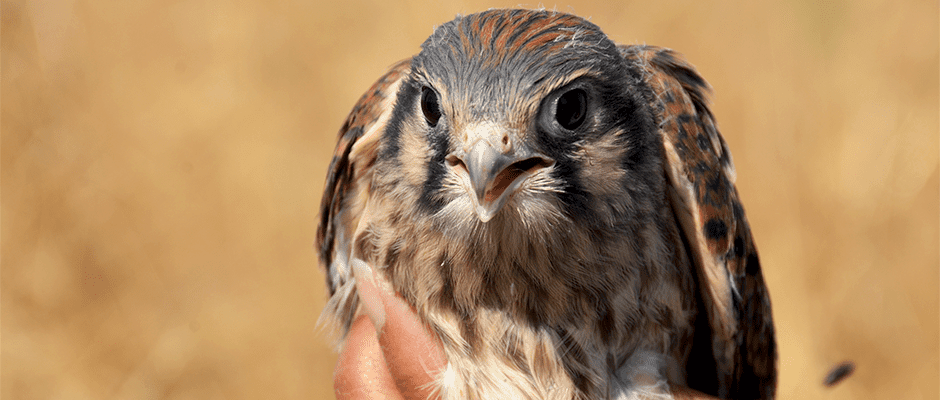Share this article
Site Visit Insights: Kestrels soar at Air Force base
Site visits are critical to helping scientists learn more about species and their habitats. The trips often take them into areas most people do not have a chance to explore, including public and privately-owned restricted sites, as well as some remote and hard-to-reach areas. “Site visit Insights” provides a behind-the-scenes perspective of wildlife biology, featuring photographs and interesting discoveries and happenings biologists experience in the field.
In cooperation with the U.S. Fish and Wildlife Service, The Wildlife Society is pleased to share these insights.
Wildlife Biologist: Harry Kahler, fish and wildlife biologist, Sacramento Fish and Wildlife Office
Site visit location: Beale Air Force Base, California
What was the purpose of the site visit?

Fish and Wildlife Biologist Harry Kahler bands a nine-day-old kestrel, which can help identify the bird at a future encounter. ©Veronica Davison, USFWS
The purpose of this site visit was to band and collect information about American kestrel (Falco sparverius) nestlings. Nesting sites for American kestrels are limited. As part of The Peregrine Fund’s American Kestrel Partnership, the Sacramento Fish and Wildlife Office installed a series of kestrel nest boxes at various sites on Beale Air Force Base. We monitor them for use and productivity during the breeding season each spring. We collect basic information about the eggs and nestlings we find at each location and fit the nestlings with metal bands for future identification. Along with other data collected throughout the range of the kestrel, our nest box information will help provide clues as to why American kestrel populations are declining.
The American kestrel is not on the endangered species list, but it is protected by the Migratory Bird Treaty Act. It is the smallest falcon found throughout the Americas. Since scientists began collecting breeding bird survey data in the 1960s, population declines of American kestrels have been reported across the species range. Although the cause of the decline is not clear, loss of adequate breeding habitat is one potential explanation.
During the breeding season, kestrels require open woodlands or grasslands for foraging, with suitable tree cavities for nesting. They are tolerant of most human activities and will readily nest in manmade boxes when cavities are not available. Nesting sites that are relatively free from human disturbance are more successful at producing fledglings. Where possible, our boxes were placed in areas without frequent human activity, and away from areas that may interfere with the base’s military operations.
Where did you go?
Beale Air Force Base in Yuba County, California. The base serves as excellent habitat for wildlife and is home to critters of all types—from snakes and fish to birds and mountain lions.
What partners were you working with and what is the nature of SFWO’s partnership with them?
We partner with representatives from the California Department of Fish and Wildlife and Beale Air Force Base. Without our partners, this project wouldn’t be possible.
We work closely with representatives from Beale Air Force Base to ensure that the nest boxes are placed in areas that won’t interfere with critical missions of the base. As part of the Sikes Act, the Service partners with the military nationwide to ensure that about 25 million acres of land containing military installations can support ecosystems while fulfilling military obligations. The land is largely protected from development.
To monitor the boxes, document observations, and band the nestlings, we work with the California Department of Fish and Wildlife.
What did you learn from this site visit that you didn’t know before?

Fish and Wildlife Biologist Harry Kahler gets help from Assistant Field Supervisor Doug Weinrich as he carefully removes the chicks from the nesting box one-by-one and transfers them into a soft bag Weinrich is holding. ©Veronica Davison, USFWS
Our nest boxes were installed in a variety of places: some hilly, some flat, some remote, and some closer to buildings. Not all boxes placed in areas that looked highly suitable to the human eye were used by the kestrels, while other boxes placed in areas that seemed less adequate were selected by the birds.
The average clutch size, or number of eggs laid in a breeding attempt, is 4 to 5 eggs. This year we observed several clutch sizes of 6 or 7 eggs. Also, raising a full brood of 5 chicks or more to fledging requires plentiful food resources. Although our data are limited, these larger clutch sizes and fledgling success may indicate that Beale Air Force Base provides excellent habitat for American kestrels.
In all, nest box selection and nesting success varies from year to year. It’s an important reminder that relationships between wildlife and habitats are multi-faceted and complex. The data we collect each year is compiled with information from other studies across the entire population range of the American kestrel to help us better understand the relationship between wildlife and habitat for this species.
What surprises did you encounter during the site visit?
It’s not easy to be an American kestrel. Nest boxes can be chilly or very hot, and invariably they are also inhabited by ants and other crawling insects. Even chicks that were just a few days old already had mites covering them. In other cases, some eggs didn’t even get that far along, as we found evidence of a mother kestrel being preyed upon before her eggs hatched. Unfortunately, without her to keep them warm, her eggs did not hatch.
They’re born with talons and a beak that comes into play very early. Handling nestlings that are just 7-10 days old, for example, can seem like trying to get ahold of a contorting pin cushion! By the time they leave the nest after about a month, they are fully capable capturing prey. Seeing these struggles firsthand fully demonstrates the challenges and beauty of our successful conservation efforts.
Learn more about American Kestrels
Header Image: A biologist holds a 28-day-old American kestrel. ©Veronica Davison, USFWS








